More people are using electronic cigarettes/vapes
Electronic cigarettes or vapes (referred to collectively as ‘e‑cigarettes’) are personal vaping devices where users inhale aerosol rather than smoke. The inhaled aerosol usually contains flavourings, a range of toxic chemicals, and may contain nicotine as well (Department of Health and Aged Care 2023a).
E‑cigarette policy in Australia
From early 2024, stronger controls on the importation, manufacture, advertising, supply and commercial possession of all e‑cigarette devices and components (with and without nicotine) are being implemented by the Australian Government. These regulatory changes are being implemented by the Federal Government in stages during 2024 in partnership with State and Territory Governments (TGA 2023).
The 2022–2023 NDSHS was conducted before these restrictions were put into place. At the time, in most jurisdictions, it was legal for adults to purchase e‑cigarettes that did not contain nicotine from a broad range of retail settings, including those used to purchase tobacco products. Prior to 2024, adults could also import nicotine e‑cigarettes with a prescription via the personal importation scheme.
These results reflect the prevalence of e‑cigarette use in Australia prior to the new restrictions coming into effect in 2024.
Table 1: Snapshot of e‑cigarette use among people aged 14 and over in 2022–2023Lifetime use1 | 19.8% |
|---|
Currently use2 | 7.0% |
|---|
Change since 2019 | ↑Lifetime use (11.3%) ↑Currently use (2.5%) |
|---|
Change since 2016 | ↑Lifetime use (8.8%) ↑Currently use (1.2%) |
|---|
Table 2: Snapshot of e‑cigarette use among people aged 14 and over who were currently using e-cigarettes in 2022–2023Age group most likely to currently use (%) | 18–24 (21%) |
|---|
Used daily (%) | 49% |
|---|
Age of initiation | 28.9 years (2019: 31.0 years) |
|---|
Top reason for first using | “Out of curiosity” (39%) |
|---|
Last e‑cigarette used contained nicotine | 73% |
|---|
Notes
- 'Lifetime use' includes people who reported having used e‑cigarettes at least once in their lifetime.
- ‘Currently using’ includes people who were using e‑cigarettes daily, at least weekly, at least monthly, or less often than monthly.
Source: National Drug Strategy Household Survey 2022–2023.
More people are using e‑cigarettes in Australia. In 2022–2023, 1 in 5 (19.8%) people aged 14 and over in Australia reported having used e‑cigarettes at least once in their lifetime, with 7% currently using e‑cigarettes at least daily, weekly, monthly, or less often than monthly. This was a large increase from 2019, when only 11.3% of people had ever used e‑cigarettes, and 2.5% were currently using them (Figure 1). The proportion of people who used e‑cigarettes daily in 2022–2023 was 3.5%, rising from 1.1% in 2019.
Figure 1: Use of e‑cigarettes, proportion of people and population, people aged 14 and over, 2016 to 2022–2023
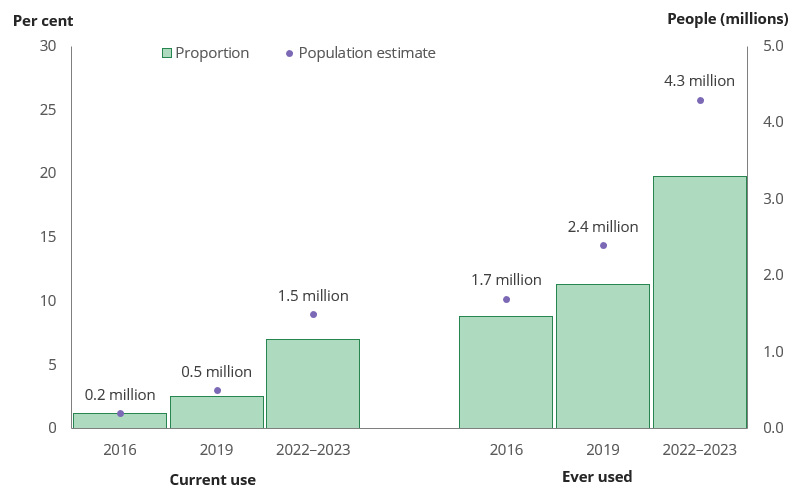
Notes:
- ‘Current use’ includes people who were using e‑cigarettes daily, at least weekly, at least monthly, or less often than monthly.
- ‘Ever used’ includes ‘Current use’.
Source: NDSHS 2022–2023, Tables 3.1–3.4.
Among people who were currently using e‑cigarettes, the proportion of people who used them daily remained stable from 2016 (42%) to 2019 (42%), then increased in 2022–2023 (49%). While more males than females used e‑cigarettes daily, the change among females was much greater than among males, rising from 36% in 2019 to 51% in 2022–2023. This corresponds to a fourfold increase in the number of females using e‑cigarettes daily, from approximately 70,000 to 300,000 (Figure 2).
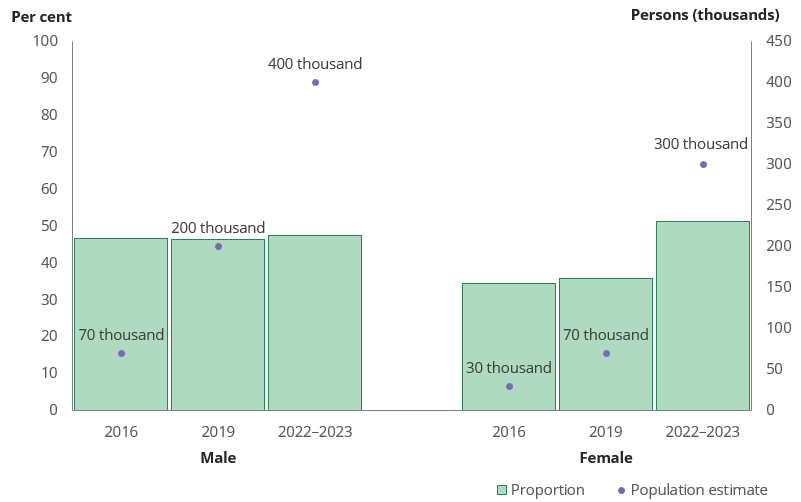
Note: Data are limited to people who were using e‑cigarettes daily, at least weekly, at least monthly, or less often than monthly.
Source: NDSHS 2022–2023, Tables 3.6 and 3.8.
Young people aged 18 to 24 were the most likely to have used e‑cigarettes in 2022–2023, with almost 1 in 2 (49%) having used them at least once in their lifetime, and over 1 in 5 (21%) currently using e‑cigarettes in 2022–2023. More information on young people’s use of vapes and e-cigarettes can be found online.
Use of nicotine more likely when people use e‑cigarettes more often
People who used e‑cigarettes more often were more likely to report that their last used e‑cigarette contained nicotine. In 2022–2023:
- Around half of people who had ever used e‑cigarettes (54%) reported that the last one they used contained nicotine.
- For people who were currently using e‑cigarettes, almost three quarters (73%) reported that the last one they used contained nicotine.
- For people who used e‑cigarettes daily, over 4 in 5 (85%) reported that the last one they used contained nicotine.
In Australia, during the survey period, it was not legal to obtain e‑cigarettes containing nicotine without a prescription (TGA 2020). However, 87% of people who reported using e‑cigarettes with nicotine had obtained them without prescriptions.
More people are currently using both regular cigarettes and e‑cigarettes
Between 2016 and 2022–2023, the proportion of people who both smoked regular (combustible) tobacco cigarettes and used e‑cigarettes increased, as did the proportion who currently used e‑cigarettes but did not use regular cigarettes. In 2022–2023, 2.3% of people in Australia both smoked regular cigarettes and used e‑cigarettes, an increase from 0.7% in 2016.
The proportion of people neither smoking regular cigarettes nor using e‑cigarettes has remained stable (Figure 3).
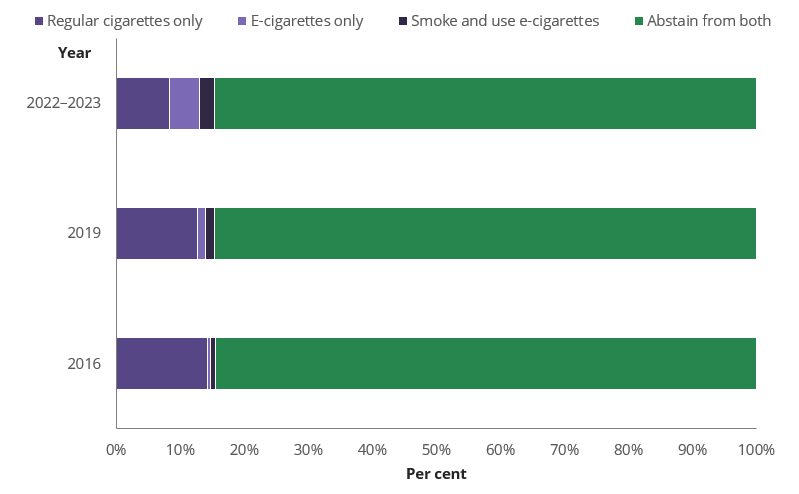
Note: People who used regular cigarettes include people who smoked tobacco daily, at least weekly, or less than weekly. Use of e‑cigarettes includes people who used e‑cigarettes daily, at least weekly, at least monthly, or less often than monthly.
Source: NDSHS 2022–2023, Table 3.41.
Social and economic factors shape people’s behaviours of vaping or smoking. Generally, people living in the most disadvantaged socioeconomic areas were the most likely to currently smoke regular cigarettes but not use e‑cigarettes (13.2%). In contrast, people living in the most advantaged socioeconomic areas were the most likely to use e‑cigarettes but not smoke regular cigarettes (6.6%) (Figure 4).
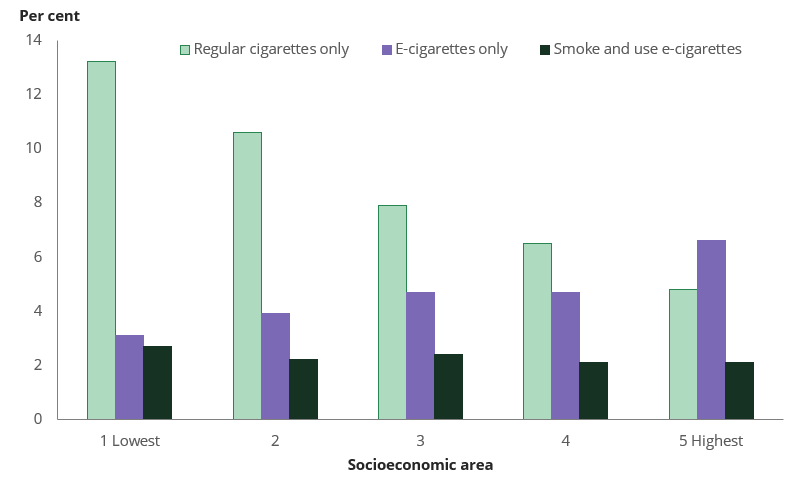
Note: People who used regular cigarettes include people who smoked tobacco daily, at least weekly, or less than weekly. Use of e‑cigarettes includes people who used e‑cigarettes daily, at least weekly, at least monthly, or less often than monthly.
Source: NDSHS 2022–2023, Table 3.43.
How many people are using e‑cigarettes to quit smoking?
Results from the National Drug Strategy Household Survey do not provide evidence for or against the use of e-cigarettes as a smoking cessation tool, or as a gateway to tobacco smoking. The age groups most likely to smoke tobacco in 2019 and 2022–2023 were the least likely to use e-cigarettes, and the age groups most likely to use e-cigarettes had low tobacco smoking rates in 2019 and 2022–2023.
In general, people using e‑cigarettes did not report doing so in order to quit smoking regular tobacco cigarettes. In 2022–2023, only 1 in 5 (21%) people who had ever used e‑cigarettes reported that they first used e‑cigarettes to help them quit smoking (Figure 5). The most common reason people gave for using e‑cigarettes was out of curiosity (58%). This was especially the case for people aged 14 to 17 (74%) and 18 to 24 (68%).
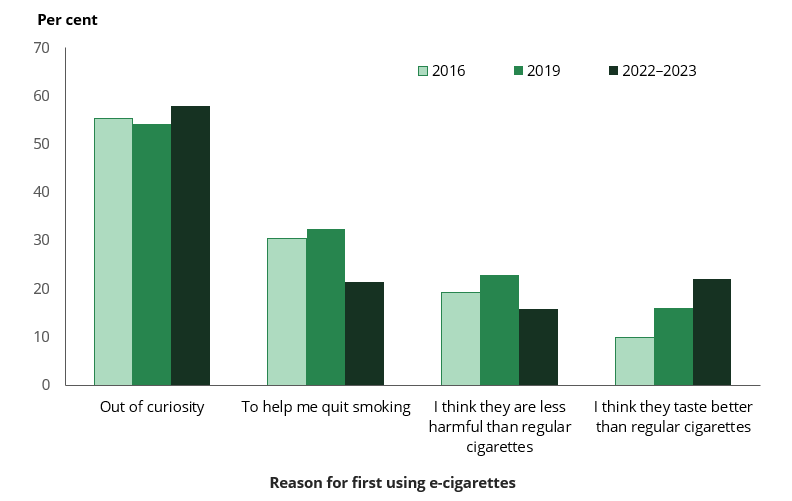
Note: Data are limited to people who had ever used an e‑cigarette.
Source: Table 3.35.
Support for e‑cigarette policies
With the increasing use of e‑cigarettes, there has been greater support for policies aimed at controlling the prevalence of e‑cigarettes.
According to the National Tobacco Strategy 2023–2030 (Department of Health and Aged Care 2023b), strengthening regulations on e‑cigarettes has been listed as a priority area, and actions such as prohibiting the sale of flavoured e‑cigarettes have been proposed. Restrictions on importation, packaging and flavourings will come into effect in early 2024 (TGA 2023). Between 2012 and 2022, most Australian jurisdictions have amended their laws to further restrict the advertising and sale of e‑cigarettes (Department of Health and Aged Care 2023b).
The Australian Government’s new Public Health (Tobacco and Other Products) legislation commences from April 2024 and incorporates new controls governing the advertising and promotion of e‑cigarettes (Department of Health and Aged Care 2024).
The 2022–2023 NDSHS had a series of questions regarding policy measures designed to address e‑cigarette use. Support increased for all e‑cigarette policy options among the Australian population (Figure 6). Almost 9 in 10 people (86%) supported prohibiting the sale of e‑cigarettes to people under 18 years of age, a substantial increase from 2019 (79%).
The second most supported measure, strengthening restrictions on the advertising and promotion of e‑cigarettes, was supported by 82% of people. In 2019, only 67% of people in Australia supported strengthening these restrictions.
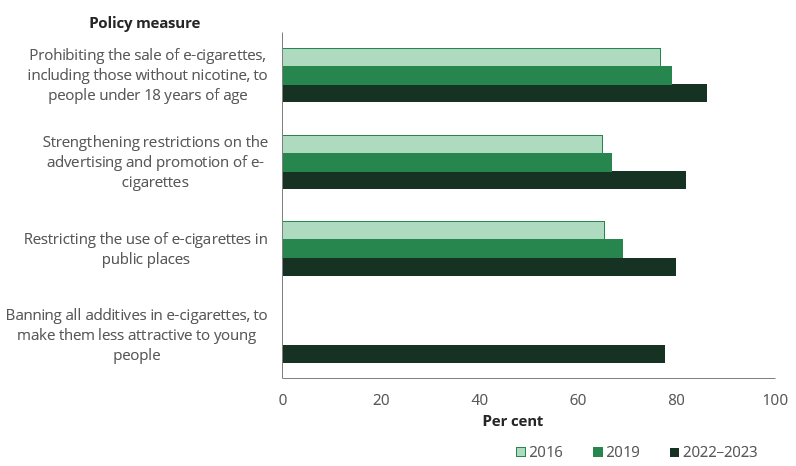
Source: NDSHS 2022–2023, Table 3.44.
In comparison to the general population, support for these measures varied greatly among people who currently used e‑cigarettes. The most supported measure was prohibiting the sale of e‑cigarettes to people under 18 years of age (67%), while the least supported measure was banning all additives in e‑cigarettes, to make them less attractive to young people (33%) (Figure 7).
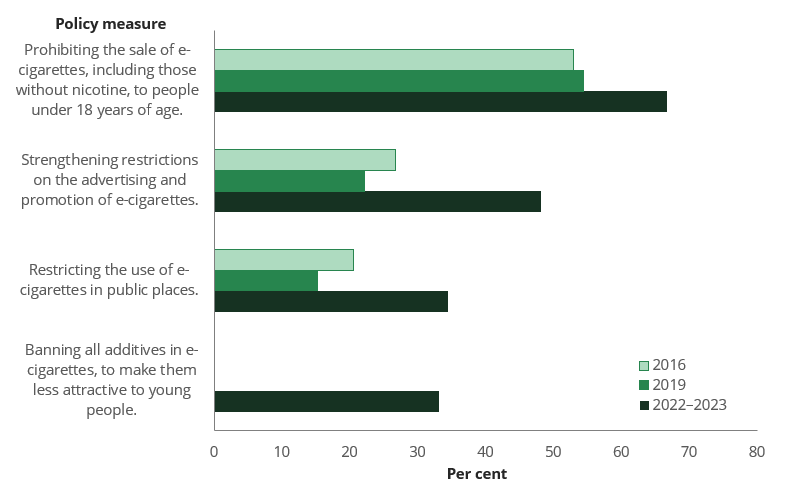
Note: Current use includes people using e‑cigarettes daily, at least weekly, at least monthly, or less often than monthly.
Source: Table 3.46.


